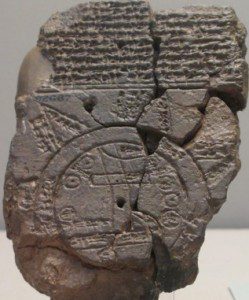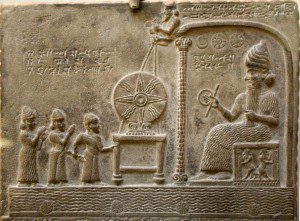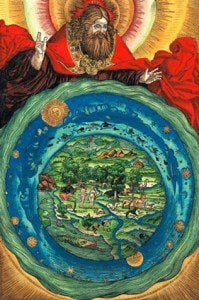 The second and third chapters of Kyle Greenwood’s new book Scripture and Cosmology: Reading the Bible Between the Ancient World and Modern Science deal with ancient Near Eastern cosmologies and the cosmologies found in Scripture. In these chapters Greenwood argues that the ancient Near Eastern view of the world was intrinsically three-tiered and that Scripture reflects this view. (The image to the right is an ancient Babylonian map of the world, ca. 500 to 700 BC, now in the British Museum.)
The second and third chapters of Kyle Greenwood’s new book Scripture and Cosmology: Reading the Bible Between the Ancient World and Modern Science deal with ancient Near Eastern cosmologies and the cosmologies found in Scripture. In these chapters Greenwood argues that the ancient Near Eastern view of the world was intrinsically three-tiered and that Scripture reflects this view. (The image to the right is an ancient Babylonian map of the world, ca. 500 to 700 BC, now in the British Museum.)
The view of the world in the ancient Near East was phenomenological – it was based on the common observation of the people. Greenwood summarizes the evidence from the ancient Near East in chapter two.
The Earth was not seen as a globe. It was described and illustrated as a flat body surrounded by water. The earth is either supported on pillars or floats on top of the cosmic seas. Representations in Babylon generally show the earth supported by pillars, while in Egypt the earth was thought to float on the seas, perhaps on a (gigantic) reed mat. There are variations, however, and in one Babylonian text Marduk, the chief deity of Babylon “constructed a raft on the surface of the waters. He made earth and heaped it up on the raft.” In addition to the surface of the earth, where the people lived, the netherworld occupied space in the depths of the earth. This was a land of no return, but it was seen as part of the earth. Similar ideas are at work in Egypt. “Throughout the ancient Near East, the netherworld was a physical abode of the dead in the heart of the earth.” (p. 55)
The Heavens. There are variations in the ancient Near Eastern view of the heavens with some consistent themes. In Mesopotamia the abode of the gods was in the heavens. Egyptians had a somewhat different view. In general the sky was considered a solid structure, either a dome or a flat roof, that served as a barrier to hold back the waters above the earth. Mountains or pillars could hold up the sky, or it could be described as a tent held taught by ropes. The lower heavens contained the stars, planets, sun and moon. The upper heavens was the domain of the deities. “The Mesopotamians thought of the upper heavens as a physical realm above the upper waters. Its floor was solid, enabling residents to stand, sit, or otherwise conduct their affairs.” (p. 61)
 The Sea. In ancient Near Eastern cosmology, the earth is surrounded by cosmic waters: the oceans or seas surround the known world, water springs up from the ground, and falls from the sky – coming from all directions. Canaanite (Ugartic), Mesopotamian, and Egyptian sources portray the seas surrounding the land as chaotic, inhabited by sea serpents of various sorts. The depths of the sea are often associated with the grave. The firm surface of the sky holds back the waters above, although gates or windows let through precipitation when desired. The Sun God Tablet in the British Museum depicts Shamash (the sun god) on his throne, above the cosmic waters, with stars in the surface under the waters above the earth. In Mesopotamia, where the land was watered by rain, the waters above were crucial, providing sustenance. No rain meant drought and famine. In Egypt the annual floods of the Nile were far more important and rain was less significant. In fact the Egyptians didn’t seem to connect the water in the Nile with rain, the river itself was the source of water.
The Sea. In ancient Near Eastern cosmology, the earth is surrounded by cosmic waters: the oceans or seas surround the known world, water springs up from the ground, and falls from the sky – coming from all directions. Canaanite (Ugartic), Mesopotamian, and Egyptian sources portray the seas surrounding the land as chaotic, inhabited by sea serpents of various sorts. The depths of the sea are often associated with the grave. The firm surface of the sky holds back the waters above, although gates or windows let through precipitation when desired. The Sun God Tablet in the British Museum depicts Shamash (the sun god) on his throne, above the cosmic waters, with stars in the surface under the waters above the earth. In Mesopotamia, where the land was watered by rain, the waters above were crucial, providing sustenance. No rain meant drought and famine. In Egypt the annual floods of the Nile were far more important and rain was less significant. In fact the Egyptians didn’t seem to connect the water in the Nile with rain, the river itself was the source of water.
The people “knew” a three-tiered cosmos. “These three tiers, the heavens, the earth and the seas, provided the basic structural models necessary for explaining the entire cosmos.” (p. 69) It wasn’t merely poetic or metaphorical language in ancient eyes. Greenwood explains:
There are several reasons we must reject this notion. First, wherever we find physical descriptions of the cosmos, it is described as three-tiered. Second, wherever we find iconographic images or drawings of the cosmos, they are three-tiered. Third, nowhere in the ancient world do we find the authors explaining their cosmology in any other terms besides the three-tiered system. Finally, we know that the ancients thought of the cosmos in terms of the heavens, earth, and seas because eventually these ideas were challenged by Aristotle and Ptolemy, whose ideas were later challenged by Copernicus, Galileo, and Kepler. … In fact, the ancients very much adhered to the concept of a three-tiered cosmos. (p. 69)
 What about Cosmology in Scripture? The same view of a three-tiered cosmos permeates the Old Testament. We see references to windows in the sky (2 Kings 7:2) and repeated mention of the earth, heavens, and sea as comprising all that exists. Greenwood gives a number of examples.
What about Cosmology in Scripture? The same view of a three-tiered cosmos permeates the Old Testament. We see references to windows in the sky (2 Kings 7:2) and repeated mention of the earth, heavens, and sea as comprising all that exists. Greenwood gives a number of examples.
- Exodus 20:11: For in six days the Lord made the heavens and the earth, the sea, and all that is in them, but he rested on the seventh day.
- Nehemiah 9:6: You alone are the Lord. You made the heavens, even the highest heavens, and all their starry host, the earth and all that is on it, the seas and all that is in them. You give life to everything, and the multitudes of heaven worship you.
- Proverbs 3:19-20: By wisdom the Lord laid the earth’s foundations, by understanding he set the heavens in place; by his knowledge the watery depths were divided, and the clouds let drop the dew.
This is the only form of reference found in Scripture. “As we look through the whole of Scripture, we will note that whenever the biblical authors reference the structure of the cosmos, they do so using the same terminology and conceptual framework as their ancient counterparts.” (p. 73) There are definite differences. The sun, moon, and stars are not deities to be worshiped. God alone is sovereign over the whole and He alone is to be worshiped. But the view of the structure of the cosmos is the same.
The earth is depicted as finite and flat with no knowledge of anything but the ancient near East. The disk shaped earth is supported on foundations or pillars (Job 9:6 He shakes the earth from its place and makes its pillars tremble. Isaiah repeatedly describes God as laying the foundations of the earth). The abode of the dead is in the depths of the earth.
The heavens are portrayed as above a solid ceiling or firmament. The stars are in this firmament and either faded in the greater light of the Sun during the day or “retreated into celestial chambers where they retired during daylight hours.” (p. 88) God is in the upper heavens and is portrayed as walking on the dome or firmament. (Job 22:14: Clouds are a hiding place for Him, so that He cannot see; And He walks on the vault of heaven. Exodus 24:10 and Ezekiel 1:26 have a similar vision of God enthroned above the vault of heaven)
The sea defines the extent of the earth. There are waters above, waters below, and waters around. Rain, snow, sleet, and hail are stored above the firmament and released at the appropriate time. The biblical authors reference storehouses and windows of heaven. God is in control of the cosmic sea, providing rain (but not too much) or holding it back. He controls the waters of the deep and subdues the sea serpents that reside in the depths (Leviathan, Rahab, Tannin, and Yam)
The biblical authors “breathed the same cultural air” as the surrounding nations. Their view of the structure of the world was similar, even when their theology was distinctly different. Importantly “while astral worship was prominent in the ancient Near East, it is systematically denounced in the Bible.” (p. 102)
Greenwood concludes:
These similarities, and even the dissimilarities, indicate that the biblical authors were not engaged in a systematic correction of the pagan worldviews. We do not see these authors writing apologetic treatises against the scientifically naive viewpoints of their uninspired neighbors. They do not speak of atmospheric pressure systems affecting the weather. We do not read about the gravitational pull of the planets, the solar orbit of the earth or the earth’s rotation on its axis. The texts do not inform us of faraway galaxies, supernova, comets, or black holes. In short, the biblical authors wrote according to the best scientific evidence of their time, an observational viewpoint that was best expressed through analogy and phenomenological language. (p. 102)
The book goes into far more detail on both the ancient Near Eastern cosmologies and the reflections of these cosmologies found in scripture. There is much food for thought here. The primary point is clear: there is no new science in the bible. The intent of God’s self revelation recorded in scripture was not to teach modern science, but to be in relationship with His people. A scientific view of the structure of the cosmos was not significant to this message or relationship. The cosmology of the bible, especially the Old Testament reflects the cultural air of the time and place in which it was written. This is obvious when we dig into the text (and when it is not obscured by the translators producing our English versions).
Do you see this three-tiered view of the cosmos in Scripture?
What is the significance? Does it change the way you think about science and scripture?
If you wish to contact me directly, you may do so at rjs4mail[at]att.net
If interested you can subscribe to a full text feed of my posts at Musings on Science and Theology.











